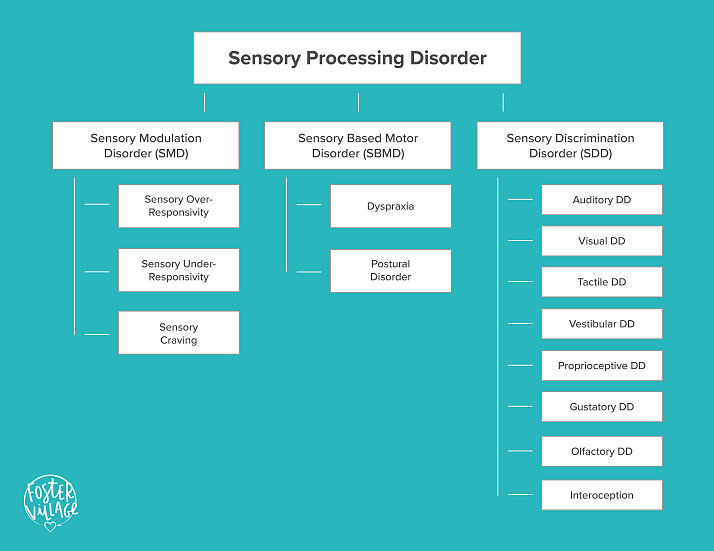The Sensory Processing Disorder Umbrella
So now that we’ve talked a little about Sensory Processing Disorder (SPD), we’re going to delve a little deeper and talk about the different types of SPDs.
In the next blog post, we’ll give you the scoop about the treatment approaches you can take to help you and the kid in your life who might be dealing with SPD.
The Three Different Patterns of SPD
Much like Autism Spectrum Disorder, SPD is an umbrella diagnosis that looks like this...

As you can see in the chart, there are three main subtypes of SPD.
And each of the three main subtypes can be broken down even further. The multiple subtypes of SPD are partly why it can be so difficult to diagnose, especially because a child can have one or a combination of the different types of SPD.
We know it’s a lot to take in but we’re going to try and make it easier to comprehend…
Here’s the skinny.
Sensory Modulation Disorder (SMD)
Sensory Modulation Disorder (SMD) is where kids have difficulty regulating their responses to sensory stimuli.
SMD can be further broken down into three categories: Sensory Over-Responsivitiy, Sensory Under-Responsivitiy, and Sensory-Craving, also known as Sensory-Seeking.
If a child struggles with sensory over-responsivity, they can over-respond or under-respond to scenarios, or can be sensory-craving. Children with sensory over-responsivity typically respond to sensory messages more intensely, more quickly, and/or for a longer time than other children. Responses may look different depending on the types of senses affected.
Your child might:
- Be upset about the texture of her food.
- Avoid going outside because it’s too bright.
- Experience challenges with transitions like moving from the house to the car.
- Avoid change and seek comfort.
When a child struggles with sensory under-responsivity, he can appear quiet and passive. These kiddos may be unaware of sensory stimuli, have delayed speech responses, or respond with less intensity than is warranted in the situation.
Your child might:
- Appear disengaged, withdrawn, or even self-absorbed.
- Have poor body awareness, which could lead to clumsiness.
- Have trouble perceiving objects as hot or cold.
If you have a kiddo who is sensory-craving or sensory-seeking, she will often crave sensory experiences and actively search for sensation in socially unacceptable ways. After she fulfills these cravings for additional stimuli, she’ll often end up being further dysregulated and sent into a disorganized state.
Your child might:
- Stand too close when talking to people and not have an understanding of personal space.
- Have an usual pain tolerance.
- Walk with loud heavy steps.
- Enjoy jumping, hopping, and bumping and crashing into things and people - sometimes with no regard to safety.
- Not know her own strength.
Sensory Based Motor Disorder (SBMD)
Sensory Based Motor Disorder (SBMD) is when kids have difficulty with balance, motor coordination, or motor tasks, and it can be identified by issues with your child’s motor functioning.
A child with Dyspraxia has a hard time translating sensory information into movements or new motor actions.
Your child might:
- Be awkward, clumsy, or accident prone.
- Have trouble with fine motor skills like coloring in the lines or dressing, or have poor handwriting.
- Break his toys.
- Perform poorly in sports that involve balls.
If your child has Postural Disorder, they will have difficulty stabilizing their body during movement or at rest to meet the demands of an environment or of a motor task.
Your child might:
- Be weak or have poor endurance.
- Have a hard time staying in a stable sitting or standing position.
Sensory Discrimination Disorder (SDD)
Sensory Discrimination Disorder (SDD) is a little more difficult to break down in manageable pieces but we’ll take a shot! SDD technically has eight subtypes because it can occur in any of the sensory areas - or even in a combination of multiple areas. Discrimination is the ability to interpret information, and SDD occurs when kids have difficulty interpreting subtle qualities of objects, places, people, or other environments. So, let’s (try to) break it down...
Auditory DD: A child has difficulty interpreting stimuli that are heard, such as distinguishing between letters or sounds like “cap” and “cat.” Your child might: Talk too loudly or softly. Experience confusion when given directions. Appear to ignore others.
Visual DD: A child has difficulty interpreting stimuli that are seen, like finding his way around an environment or having trouble recognizing objects by shape.
Your child might:
- Struggle to line up numbers in a math problem.
- Not be able to scan a page to find the keywords in a story.
- Have difficulty judging the distance between oneself and an object or person.
Tactile DD: A child has difficulty understanding what exactly is touching him and where on his body he is being touched. It is also difficult for children with tactile discrimination to determine what he touches “by feel..” They must see it.
Your child might:
- Struggle to tell the difference between a quarter and a dime in his pocket.
- Not be able to button a shirt without looking at the buttons.
Vestibular DD: A child has difficulty interpreting sensory stimuli experienced through movement of the body.
Your child might:
- Have poor awareness of movement of body in space (gets disoriented easily).
- Know he’s falling, but can’t tell which way and can’t protect himself.
Proprioceptive DD: A child has difficulty interpreting sensory stimuli experienced through the muscles or joints, such as judging how much force is required to move an object, like holding a pencil.
Your child might:
- Roughhouse to the point of someone getting hurt.
- Not be able to judge how much force to use when throwing a ball.
- Struggle to use gentle touch when petting an animal.
Gustatory DD: A child has difficulty interpreting stimuli that are tasted and may have issues with certain textures of food.
Your child might:
- Have difficulty telling the difference between things that are somewhat sweet and those that are too sweet.
Olfactory DD: A child with olfactory DD has difficulty interpreting stimuli that are smelled.
Your child might:
- Not recognize familiar smells (e.g., grandma’s perfume).
Interoception: In this case, a child may have difficulty interpreting sensory stimuli from internal organs.
Your child might:
- Struggle to recognize when she needs to go to the bathroom.
- Not feel pain, or feel pain too intensely, when something is wrong.
- Have difficulty identifying when she is thirsty, hungry, or too full.
Whew! That was A LOT of information! But good stuff to know! As you can see, there are many ways kiddos (and adults!) with SPD might behave, and that’s why it can be difficult to diagnose or treat. If you have questions, concerns, or are wondering if you kiddo may be struggling with some sensory challenges, there are resources available for you to get the support you and your family need!
Wanna Talk to Someone? There’s Help!
For starters, we’re here to help at Foster Village, so connect with us!
Primary Sources: Miller, Lucy J., et al. Sensational Kids: Hope and Help for Children with Sensory Processing Disorder. Penguin Group, 2014.
Sensory processing - star institute. Sensory Processing - STAR Institute. (n.d.). Retrieved October 6, 2021, from https://sensoryhealth.org/.
Bialer, D. S., and L. J. Miller. 2011. No Longer A SECRET: Unique Common Sense Strategies for Children with Sensory or Motor Challenges. Arlington, TX: Sensory World.


